Report on Business Decision Making and Investment Appraisal Techniques
VerifiedAdded on 2023/01/11
|8
|1434
|85
Report
AI Summary
This report provides a comprehensive analysis of business decision-making, focusing on investment appraisal techniques. The report begins with an introduction to the process of making appropriate choices for business operations, using a case study of XYZ Plc to illustrate concepts. The main body includes calculations of the payback period and net present value (NPV) for two projects, offering detailed formulas and calculations. The report also assesses financial factors, such as return on investment, opportunity cost, and inflation, and non-financial factors, including political, technological, and legal considerations. The analysis compares the two investment appraisal techniques, concluding that NPV is a more reliable method than the payback period. The report emphasizes the importance of considering both financial and non-financial factors in decision-making. The conclusion summarizes the key findings and reiterates the significance of the NPV method. The report concludes with a list of references including books and journals used in the analysis.

Business Decision Making
Paraphrase This Document
Need a fresh take? Get an instant paraphrase of this document with our AI Paraphraser
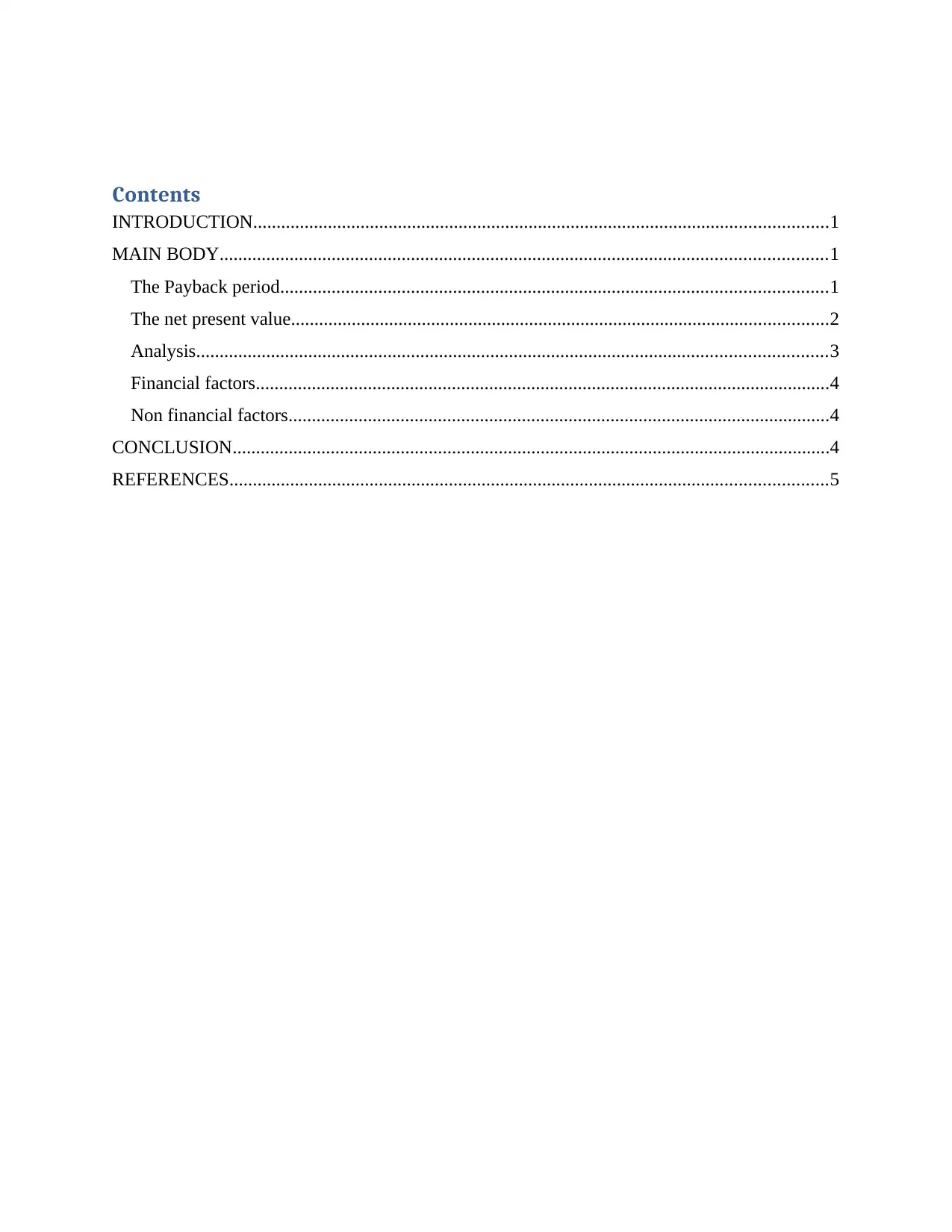
Contents
INTRODUCTION...........................................................................................................................1
MAIN BODY..................................................................................................................................1
The Payback period.....................................................................................................................1
The net present value...................................................................................................................2
Analysis.......................................................................................................................................3
Financial factors...........................................................................................................................4
Non financial factors....................................................................................................................4
CONCLUSION................................................................................................................................4
REFERENCES................................................................................................................................5
INTRODUCTION...........................................................................................................................1
MAIN BODY..................................................................................................................................1
The Payback period.....................................................................................................................1
The net present value...................................................................................................................2
Analysis.......................................................................................................................................3
Financial factors...........................................................................................................................4
Non financial factors....................................................................................................................4
CONCLUSION................................................................................................................................4
REFERENCES................................................................................................................................5

⊘ This is a preview!⊘
Do you want full access?
Subscribe today to unlock all pages.

Trusted by 1+ million students worldwide
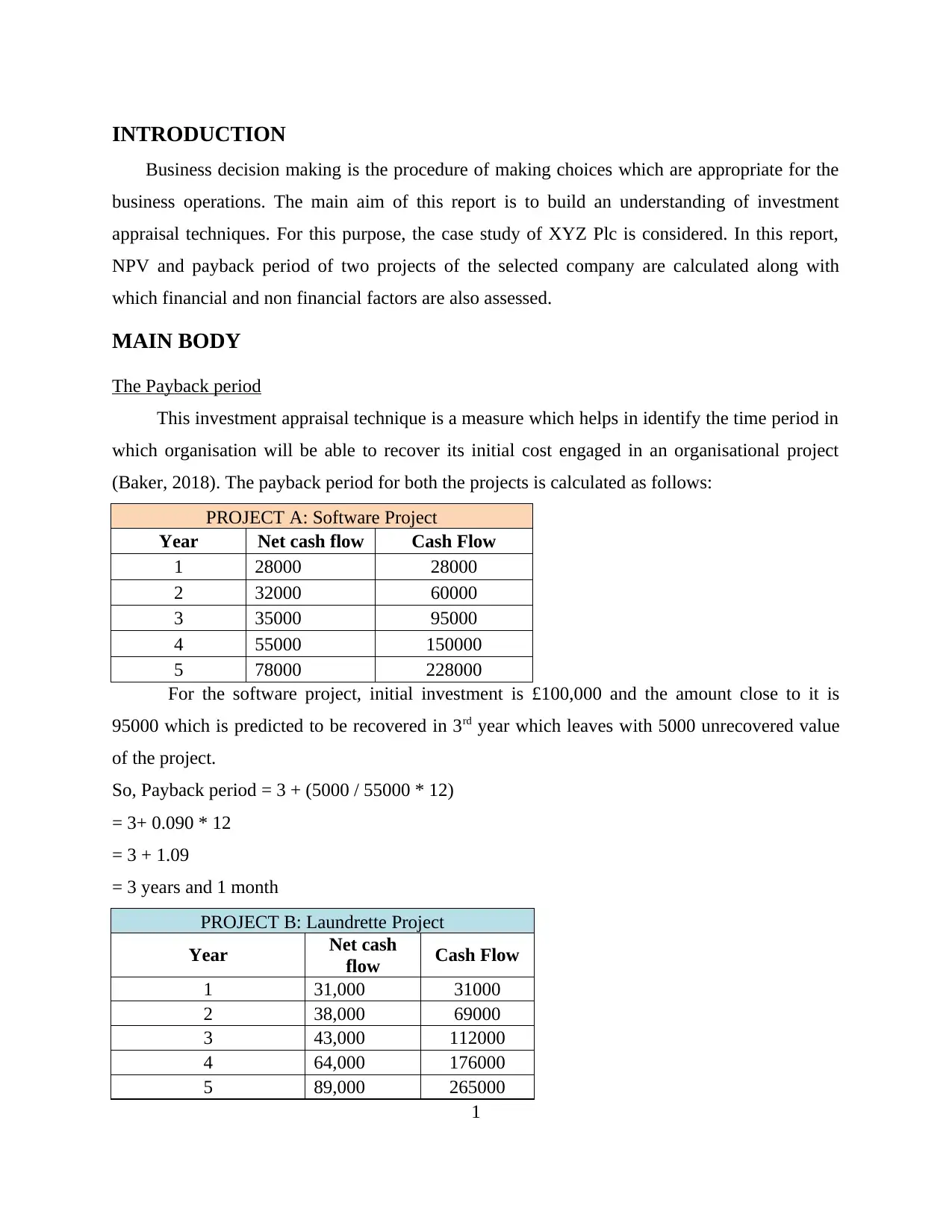
INTRODUCTION
Business decision making is the procedure of making choices which are appropriate for the
business operations. The main aim of this report is to build an understanding of investment
appraisal techniques. For this purpose, the case study of XYZ Plc is considered. In this report,
NPV and payback period of two projects of the selected company are calculated along with
which financial and non financial factors are also assessed.
MAIN BODY
The Payback period
This investment appraisal technique is a measure which helps in identify the time period in
which organisation will be able to recover its initial cost engaged in an organisational project
(Baker, 2018). The payback period for both the projects is calculated as follows:
PROJECT A: Software Project
Year Net cash flow Cash Flow
1 28000 28000
2 32000 60000
3 35000 95000
4 55000 150000
5 78000 228000
For the software project, initial investment is £100,000 and the amount close to it is
95000 which is predicted to be recovered in 3rd year which leaves with 5000 unrecovered value
of the project.
So, Payback period = 3 + (5000 / 55000 * 12)
= 3+ 0.090 * 12
= 3 + 1.09
= 3 years and 1 month
PROJECT B: Laundrette Project
Year Net cash
flow Cash Flow
1 31,000 31000
2 38,000 69000
3 43,000 112000
4 64,000 176000
5 89,000 265000
1
Business decision making is the procedure of making choices which are appropriate for the
business operations. The main aim of this report is to build an understanding of investment
appraisal techniques. For this purpose, the case study of XYZ Plc is considered. In this report,
NPV and payback period of two projects of the selected company are calculated along with
which financial and non financial factors are also assessed.
MAIN BODY
The Payback period
This investment appraisal technique is a measure which helps in identify the time period in
which organisation will be able to recover its initial cost engaged in an organisational project
(Baker, 2018). The payback period for both the projects is calculated as follows:
PROJECT A: Software Project
Year Net cash flow Cash Flow
1 28000 28000
2 32000 60000
3 35000 95000
4 55000 150000
5 78000 228000
For the software project, initial investment is £100,000 and the amount close to it is
95000 which is predicted to be recovered in 3rd year which leaves with 5000 unrecovered value
of the project.
So, Payback period = 3 + (5000 / 55000 * 12)
= 3+ 0.090 * 12
= 3 + 1.09
= 3 years and 1 month
PROJECT B: Laundrette Project
Year Net cash
flow Cash Flow
1 31,000 31000
2 38,000 69000
3 43,000 112000
4 64,000 176000
5 89,000 265000
1
Paraphrase This Document
Need a fresh take? Get an instant paraphrase of this document with our AI Paraphraser
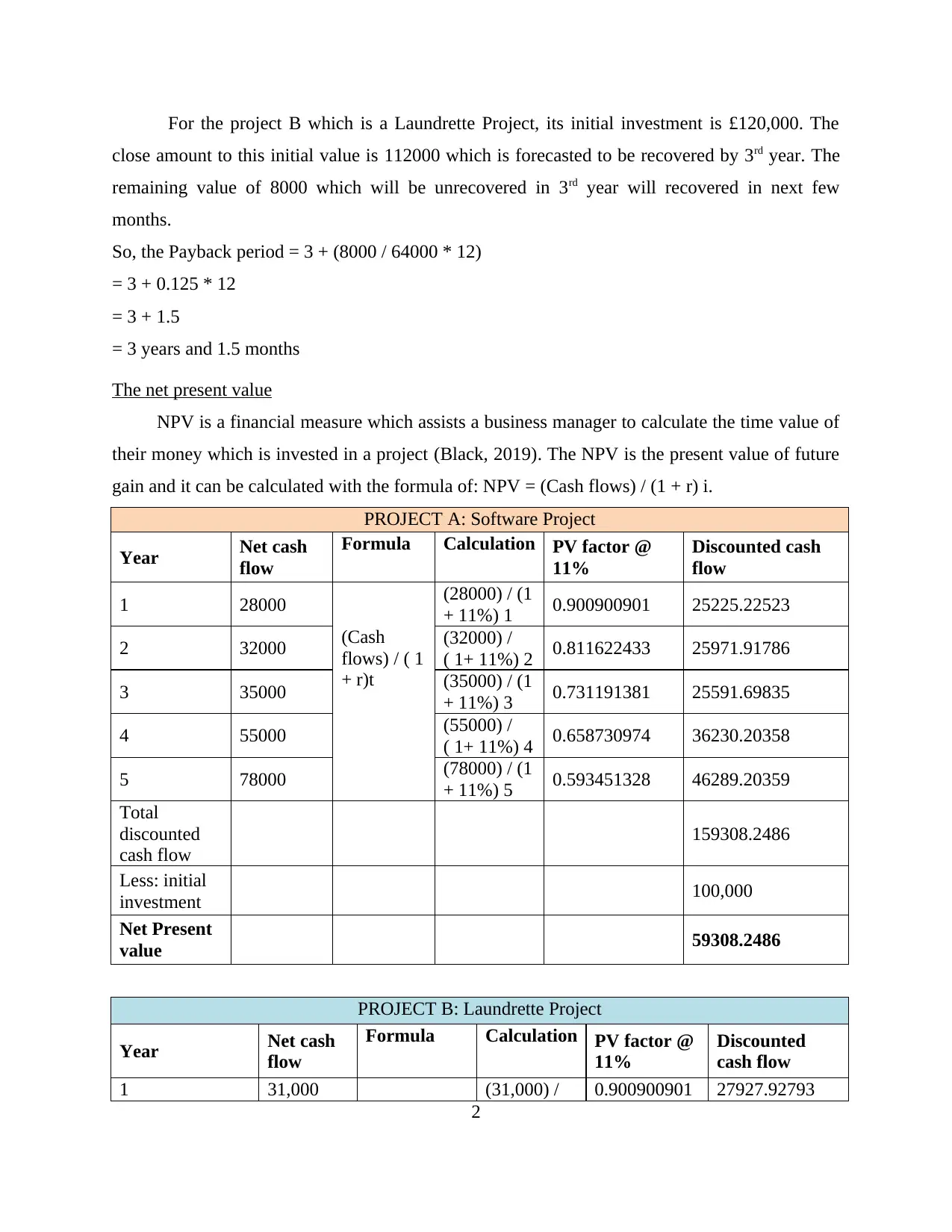
For the project B which is a Laundrette Project, its initial investment is £120,000. The
close amount to this initial value is 112000 which is forecasted to be recovered by 3rd year. The
remaining value of 8000 which will be unrecovered in 3rd year will recovered in next few
months.
So, the Payback period = 3 + (8000 / 64000 * 12)
= 3 + 0.125 * 12
= 3 + 1.5
= 3 years and 1.5 months
The net present value
NPV is a financial measure which assists a business manager to calculate the time value of
their money which is invested in a project (Black, 2019). The NPV is the present value of future
gain and it can be calculated with the formula of: NPV = (Cash flows) / (1 + r) i.
PROJECT A: Software Project
Year Net cash
flow
Formula Calculation PV factor @
11%
Discounted cash
flow
1 28000
(Cash
flows) / ( 1
+ r)t
(28000) / (1
+ 11%) 1 0.900900901 25225.22523
2 32000 (32000) /
( 1+ 11%) 2 0.811622433 25971.91786
3 35000 (35000) / (1
+ 11%) 3 0.731191381 25591.69835
4 55000 (55000) /
( 1+ 11%) 4 0.658730974 36230.20358
5 78000 (78000) / (1
+ 11%) 5 0.593451328 46289.20359
Total
discounted
cash flow
159308.2486
Less: initial
investment 100,000
Net Present
value 59308.2486
PROJECT B: Laundrette Project
Year Net cash
flow
Formula Calculation PV factor @
11%
Discounted
cash flow
1 31,000 (31,000) / 0.900900901 27927.92793
2
close amount to this initial value is 112000 which is forecasted to be recovered by 3rd year. The
remaining value of 8000 which will be unrecovered in 3rd year will recovered in next few
months.
So, the Payback period = 3 + (8000 / 64000 * 12)
= 3 + 0.125 * 12
= 3 + 1.5
= 3 years and 1.5 months
The net present value
NPV is a financial measure which assists a business manager to calculate the time value of
their money which is invested in a project (Black, 2019). The NPV is the present value of future
gain and it can be calculated with the formula of: NPV = (Cash flows) / (1 + r) i.
PROJECT A: Software Project
Year Net cash
flow
Formula Calculation PV factor @
11%
Discounted cash
flow
1 28000
(Cash
flows) / ( 1
+ r)t
(28000) / (1
+ 11%) 1 0.900900901 25225.22523
2 32000 (32000) /
( 1+ 11%) 2 0.811622433 25971.91786
3 35000 (35000) / (1
+ 11%) 3 0.731191381 25591.69835
4 55000 (55000) /
( 1+ 11%) 4 0.658730974 36230.20358
5 78000 (78000) / (1
+ 11%) 5 0.593451328 46289.20359
Total
discounted
cash flow
159308.2486
Less: initial
investment 100,000
Net Present
value 59308.2486
PROJECT B: Laundrette Project
Year Net cash
flow
Formula Calculation PV factor @
11%
Discounted
cash flow
1 31,000 (31,000) / 0.900900901 27927.92793
2
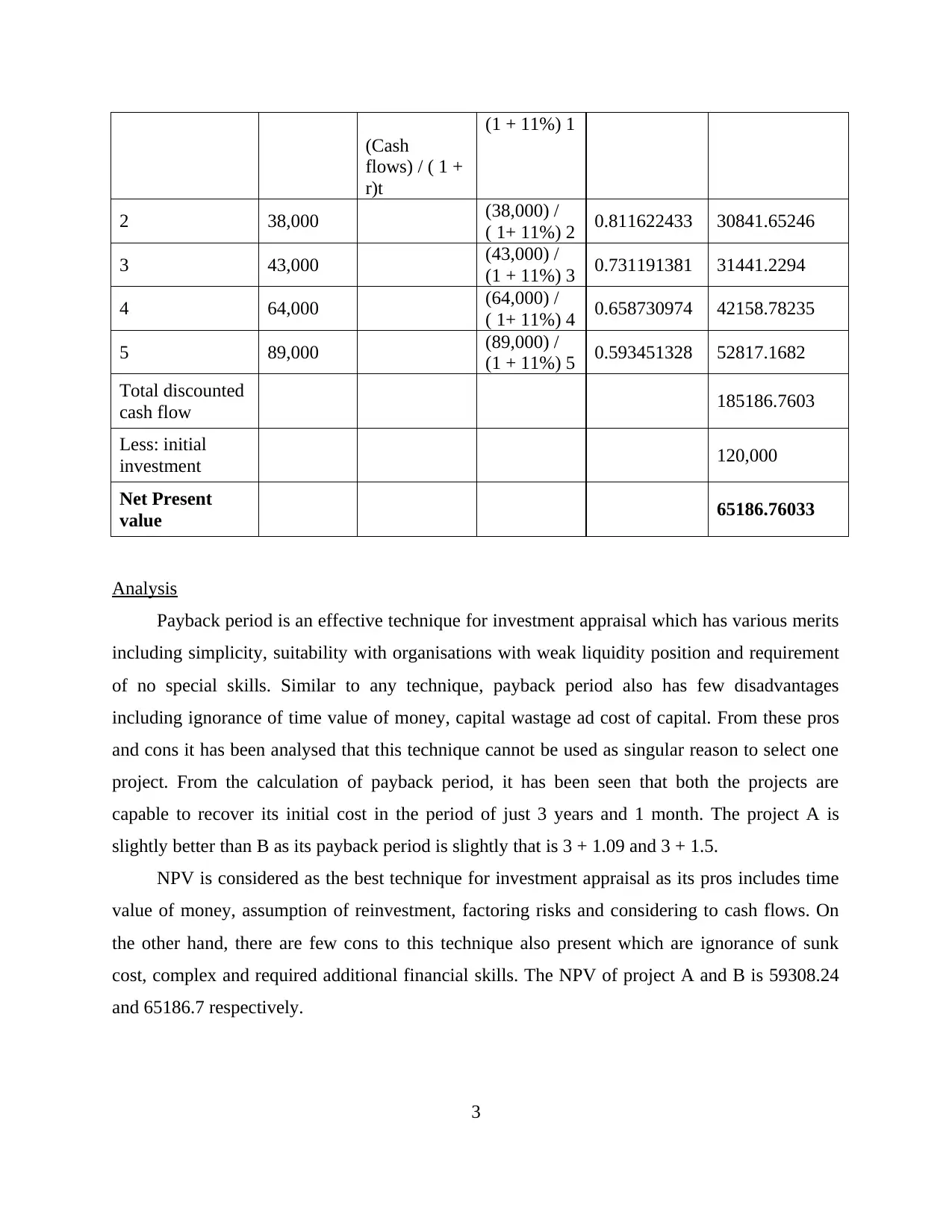
(Cash
flows) / ( 1 +
r)t
(1 + 11%) 1
2 38,000 (38,000) /
( 1+ 11%) 2 0.811622433 30841.65246
3 43,000 (43,000) /
(1 + 11%) 3 0.731191381 31441.2294
4 64,000 (64,000) /
( 1+ 11%) 4 0.658730974 42158.78235
5 89,000 (89,000) /
(1 + 11%) 5 0.593451328 52817.1682
Total discounted
cash flow 185186.7603
Less: initial
investment 120,000
Net Present
value 65186.76033
Analysis
Payback period is an effective technique for investment appraisal which has various merits
including simplicity, suitability with organisations with weak liquidity position and requirement
of no special skills. Similar to any technique, payback period also has few disadvantages
including ignorance of time value of money, capital wastage ad cost of capital. From these pros
and cons it has been analysed that this technique cannot be used as singular reason to select one
project. From the calculation of payback period, it has been seen that both the projects are
capable to recover its initial cost in the period of just 3 years and 1 month. The project A is
slightly better than B as its payback period is slightly that is 3 + 1.09 and 3 + 1.5.
NPV is considered as the best technique for investment appraisal as its pros includes time
value of money, assumption of reinvestment, factoring risks and considering to cash flows. On
the other hand, there are few cons to this technique also present which are ignorance of sunk
cost, complex and required additional financial skills. The NPV of project A and B is 59308.24
and 65186.7 respectively.
3
flows) / ( 1 +
r)t
(1 + 11%) 1
2 38,000 (38,000) /
( 1+ 11%) 2 0.811622433 30841.65246
3 43,000 (43,000) /
(1 + 11%) 3 0.731191381 31441.2294
4 64,000 (64,000) /
( 1+ 11%) 4 0.658730974 42158.78235
5 89,000 (89,000) /
(1 + 11%) 5 0.593451328 52817.1682
Total discounted
cash flow 185186.7603
Less: initial
investment 120,000
Net Present
value 65186.76033
Analysis
Payback period is an effective technique for investment appraisal which has various merits
including simplicity, suitability with organisations with weak liquidity position and requirement
of no special skills. Similar to any technique, payback period also has few disadvantages
including ignorance of time value of money, capital wastage ad cost of capital. From these pros
and cons it has been analysed that this technique cannot be used as singular reason to select one
project. From the calculation of payback period, it has been seen that both the projects are
capable to recover its initial cost in the period of just 3 years and 1 month. The project A is
slightly better than B as its payback period is slightly that is 3 + 1.09 and 3 + 1.5.
NPV is considered as the best technique for investment appraisal as its pros includes time
value of money, assumption of reinvestment, factoring risks and considering to cash flows. On
the other hand, there are few cons to this technique also present which are ignorance of sunk
cost, complex and required additional financial skills. The NPV of project A and B is 59308.24
and 65186.7 respectively.
3
⊘ This is a preview!⊘
Do you want full access?
Subscribe today to unlock all pages.

Trusted by 1+ million students worldwide

From the NPV and payback period, it has been analysed that Project B “Laundrette
Project” will be more effective for XYZ Plc., as it will benefit with high present value in the
similar payback period.
Financial factors
The financial factors which can impact the decision making procedure of an organisation are
analysed below:
Return on investment – ROI which an organisation will receive in future is the most
important factor to be considered while making an investment decision (Burgass, Arlidge
and Addison, 2018).
Opportunity cost – This will be lost due to making each decision must be identified so
that valid decision can be made (Chen, Treviño and Humphrey, 2019).
Inflation – Inflation is the gradual increase of value in market. This factor can impact the
decision of XYZ Plc. as it will impact the present value of future returns (Esch, Schulze
and Wald, 2019).
Non financial factors
Few non financial factors which can impact the investment decision making and stated
below:
Political – Industry stability in which organisation works is an important factor to be
considered as it can result in decline of the growth of entire industry (Fry, 2019).
Technological – Technological up gradation in market is a factor which can influence
business to adapt latest technology which will change their decision making process
(Hopkinson, 2017).
Legal – Future legislations can also impact the present decision in order to eliminate risk
of authorities (Si and et.al., 2016).
CONCLUSION
From the above report, it has been concluded that NPV is more reliable investment appraisal
technique than pay back period. Also, besides investment appraisal techniques, there are few
financial and non financial factors as well which can impact decision making of an organisation.
4
Project” will be more effective for XYZ Plc., as it will benefit with high present value in the
similar payback period.
Financial factors
The financial factors which can impact the decision making procedure of an organisation are
analysed below:
Return on investment – ROI which an organisation will receive in future is the most
important factor to be considered while making an investment decision (Burgass, Arlidge
and Addison, 2018).
Opportunity cost – This will be lost due to making each decision must be identified so
that valid decision can be made (Chen, Treviño and Humphrey, 2019).
Inflation – Inflation is the gradual increase of value in market. This factor can impact the
decision of XYZ Plc. as it will impact the present value of future returns (Esch, Schulze
and Wald, 2019).
Non financial factors
Few non financial factors which can impact the investment decision making and stated
below:
Political – Industry stability in which organisation works is an important factor to be
considered as it can result in decline of the growth of entire industry (Fry, 2019).
Technological – Technological up gradation in market is a factor which can influence
business to adapt latest technology which will change their decision making process
(Hopkinson, 2017).
Legal – Future legislations can also impact the present decision in order to eliminate risk
of authorities (Si and et.al., 2016).
CONCLUSION
From the above report, it has been concluded that NPV is more reliable investment appraisal
technique than pay back period. Also, besides investment appraisal techniques, there are few
financial and non financial factors as well which can impact decision making of an organisation.
4
Paraphrase This Document
Need a fresh take? Get an instant paraphrase of this document with our AI Paraphraser
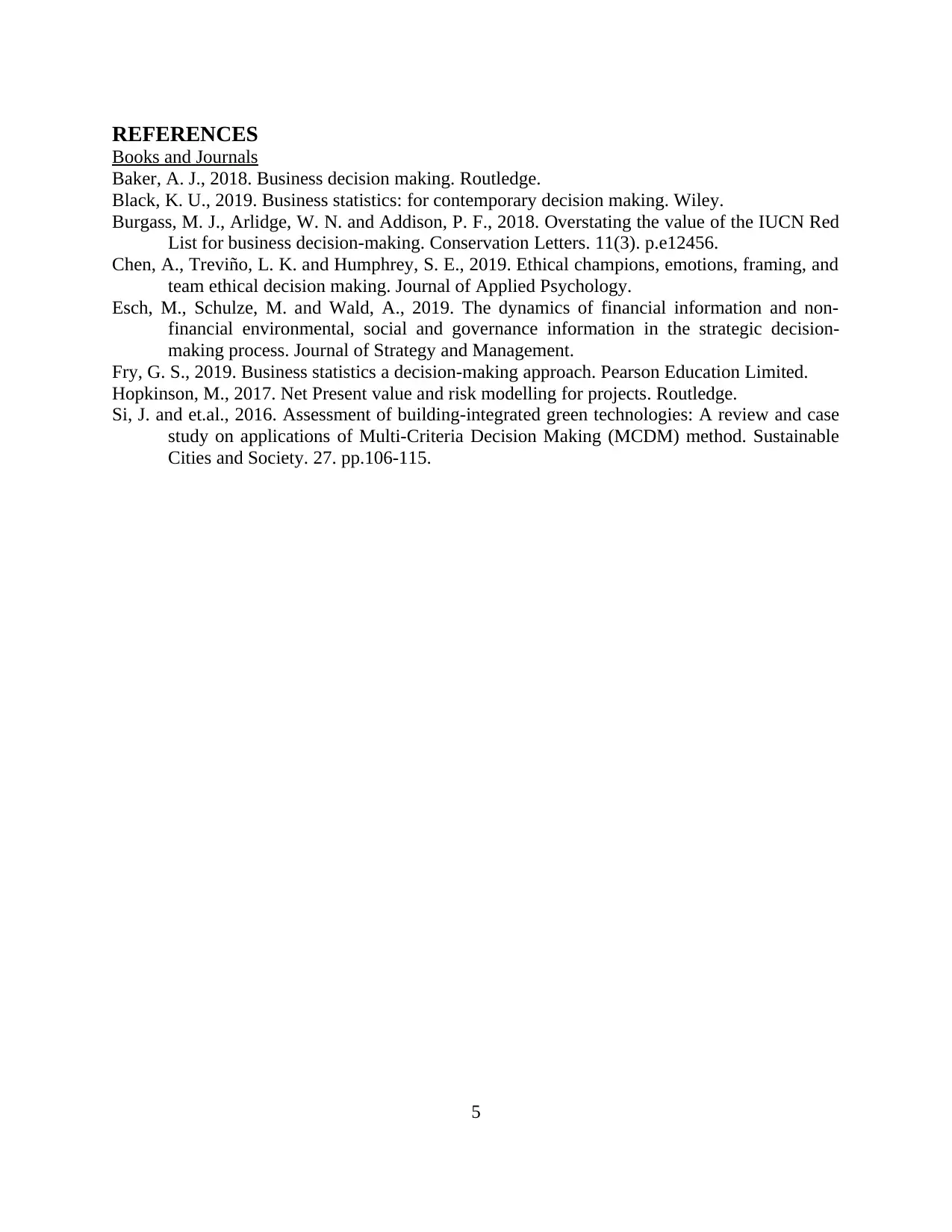
REFERENCES
Books and Journals
Baker, A. J., 2018. Business decision making. Routledge.
Black, K. U., 2019. Business statistics: for contemporary decision making. Wiley.
Burgass, M. J., Arlidge, W. N. and Addison, P. F., 2018. Overstating the value of the IUCN Red
List for business decision‐making. Conservation Letters. 11(3). p.e12456.
Chen, A., Treviño, L. K. and Humphrey, S. E., 2019. Ethical champions, emotions, framing, and
team ethical decision making. Journal of Applied Psychology.
Esch, M., Schulze, M. and Wald, A., 2019. The dynamics of financial information and non-
financial environmental, social and governance information in the strategic decision-
making process. Journal of Strategy and Management.
Fry, G. S., 2019. Business statistics a decision-making approach. Pearson Education Limited.
Hopkinson, M., 2017. Net Present value and risk modelling for projects. Routledge.
Si, J. and et.al., 2016. Assessment of building-integrated green technologies: A review and case
study on applications of Multi-Criteria Decision Making (MCDM) method. Sustainable
Cities and Society. 27. pp.106-115.
5
Books and Journals
Baker, A. J., 2018. Business decision making. Routledge.
Black, K. U., 2019. Business statistics: for contemporary decision making. Wiley.
Burgass, M. J., Arlidge, W. N. and Addison, P. F., 2018. Overstating the value of the IUCN Red
List for business decision‐making. Conservation Letters. 11(3). p.e12456.
Chen, A., Treviño, L. K. and Humphrey, S. E., 2019. Ethical champions, emotions, framing, and
team ethical decision making. Journal of Applied Psychology.
Esch, M., Schulze, M. and Wald, A., 2019. The dynamics of financial information and non-
financial environmental, social and governance information in the strategic decision-
making process. Journal of Strategy and Management.
Fry, G. S., 2019. Business statistics a decision-making approach. Pearson Education Limited.
Hopkinson, M., 2017. Net Present value and risk modelling for projects. Routledge.
Si, J. and et.al., 2016. Assessment of building-integrated green technologies: A review and case
study on applications of Multi-Criteria Decision Making (MCDM) method. Sustainable
Cities and Society. 27. pp.106-115.
5
1 out of 8
Related Documents
Your All-in-One AI-Powered Toolkit for Academic Success.
+13062052269
info@desklib.com
Available 24*7 on WhatsApp / Email
![[object Object]](/_next/static/media/star-bottom.7253800d.svg)
Unlock your academic potential
Copyright © 2020–2025 A2Z Services. All Rights Reserved. Developed and managed by ZUCOL.





